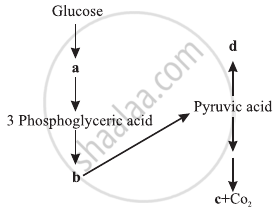Advertisements
Advertisements
Question
ATP produced during glycolysis is a result of substrate level phosphorylation. Explain.
Solution
When the formation of ATP happens by direct transfer of a phosphoryl (PO3) group to ADP from a phosphorylated reactive intermediate, this is called substrate-level phosphorylation. During glycolysis, ATP is formed at two stages because of the direct transfer of the phosphoryl group to ADP.
- When BPGA (bisphosphoglyceric acid) is converted into PGA (phosphoglyceric acid).
- When PEP (phosphoenolpyruvate) is converted into pyruvic acid.
APPEARS IN
RELATED QUESTIONS
Following reactions occur during glycolysis. Arrange them in the order of their occurrence in the glycolytic pathway.
- Dihydroxy acetone phosphate → Glyceraldehyde-3-phosphate
- Fructose-6-phosphate → Fructose-1, 6-bisphosphate
- Phosphoenolpyruvate → Pyruvic acid
- 2-Phosphoglycerat → Phosphoenolpyruvate
- Glucose-6-phosphate → Fructose-6- phosphate
- 1,3-bisphosphoglyceric acid → 3- phosphoglyceric acid
In glycolysis, Fructose 1,6-bisphosphate formed from fructose-6-phosphate is cleaved into ______.
During glycolysis of aerobic respiration, how many times oxidation of substrate occurs?
Which one of the following is the first step of glycolysis?
Which of the following will release more energy on oxidation? Arrange them in ascending order.
- 1 gm of fat
- 1 gm of protein
- 1 gm of glucose
- 0.5 g of protein + 0.5g glucose
Comment on the statement – Respiration is an energy producing process but ATP is being used in some steps of the process.
We commonly call ATP as the energy currency of the cell. Can you think of some other energy carriers present in a cell? Name any two.
In the following flow chart, replace the symbols a,b,c and d with appropriate terms. Briefly explain the process and give any two application of it.

Formation of acetyl CoA from pyruvic acid takes place by ______.
The first three steps of glycolysis are called as ______.
